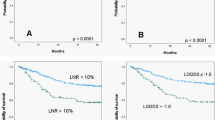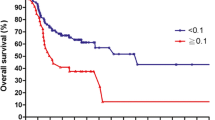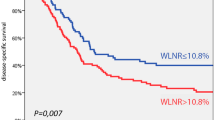Abstract
In head and neck squamous cell carcinoma (HNSCC), the search for better prognostic factors beyond TNM-stage is ongoing. Lymph node ratio (LNR) (positive lymph nodes/total lymph nodes) is gaining interest in view of its potential prognostic significance. All HNSCC patients at the Netherlands Cancer Institute undergoing neck dissection for lymph node metastases in the neck region between 2002 and 2012 (n = 176) were included. Based on a protocol change in specimen processing, the cohort was subdivided in two distinct consecutive periods (pre and post 2007). The prognostic value of LNR, N-stage, and number of positive lymph nodes for overall survival was assessed. The mean number of examined lymph nodes after 2007 was significantly higher (42.3) than before (35.8) (p = 0.024). The higher number concerned mostly lymph nodes in level V. The mean number of positive lymph nodes before 2007 was 3.3 vs. 3.6 after 2007 (p = 0.745). By multivariate analysis of both pre- and post-2007 cohort data, two factors remained associated with an increased hazard of dying: N2 [HR 2.1 (1.1–4.1) and 2.4 (1.0–5.8)] and >3 positive lymph nodes [HR 2.0 (1.1–3.5) and 3.1 (1.4–6.9)]. Hazard ratio for LNR >7 % was not significantly different: pre 2007 at 2.2 (1.3–3.8) and post 2007 at 2.1 (1.0–4.8, p = 0.053). In this study, changes in specimen processing influenced LNR values, but not the total number of tumor positive nodes found. Therefore, in HNSCC, the number of positive nodes seems a more reliable parameter than LNR, provided a minimum number of lymph nodes are examined.
Similar content being viewed by others
References
Berger AC, Sigurdson ER, LeVoyer T, Hanlon A, Mayer RJ, Macdonald JS, Catalano PJ, Haller DG (2005) Colon cancer survival is associated with decreasing ratio of metastatic to examined lymph nodes. J Clin Oncol 23:8706–8712. doi:10.1200/JCO.2005.02.8852
Bernier J, Cooper JS, Pajak TF, van Glabbeke M, Bourhis J, Forastiere A, Ozsahin EM, Jacobs JR, Jassem J, Ang KK, Lefebvre JL (2005) Defining risk levels in locally advanced head and neck cancers: a comparative analysis of concurrent postoperative radiation plus chemotherapy trials of the EORTC (#22931) and RTOG (# 9501. Head Neck 27:843–850. doi:10.1002/hed.20279
Bernier J, Domenge C, Ozsahin M, Matuszewska K, Lefebvre JL, Greiner RH, Giralt J, Maingon P, Rolland F, Bolla M, Cognetti F, Bourhis J, Kirkpatrick A, van Glabbeke M (2004) Postoperative irradiation with or without concomitant chemotherapy for locally advanced head and neck cancer. N Engl J Med 350:1945–1952. doi:10.1056/NEJMoa032641
Chang GJ, Rodriguez-Bigas MA, Skibber JM, Moyer VA (2007) Lymph node evaluation and survival after curative resection of colon cancer: systematic review. J Natl Cancer Inst 99:433–441. doi:10.1093/jnci/djk092
Dahlstrom KR, Garden AS, WN W Jr, Lim MY, Sturgis EM (2016) Proposed staging system for patients with HPV-related oropharyngeal cancer based on nasopharyngeal cancer N categories. J Clin Oncol 34:1848–1854. doi:10.1200/JCO.2015.64.6448
Ebrahimi A, Clark JR, Zhang WJ, Elliott MS, Gao K, Milross CG, Shannon KF (2011) Lymph node ratio as an independent prognostic factor in oral squamous cell carcinoma. Head Neck 33:1245–1251. doi:10.1002/hed.21600
Freeman DE, Mendenhall WM, Parsons JT, Million RR (1992) Does neck stage influence local control in squamous cell carcinomas of the head and neck? Int J Radiat Oncol Biol Phys 23:733–736
Gil Z, Carlson DL, Boyle JO, Kraus DH, Shah JP, Shaha AR, Singh B, Wong RJ, Patel SG (2009) Lymph node density is a significant predictor of outcome in patients with oral cancer. Cancer 115:5700–5710. doi:10.1002/cncr.24631
Gleisner AL, Mogal H, Dodson R, Efron J, Gearhart S, Wick E, Lidor A, Herman JM, Pawlik TM (2013) Nodal status, number of lymph nodes examined, and lymph node ratio: what defines prognosis after resection of colon adenocarcinoma? J Am Coll Surg 217:1090–1100. doi:10.1016/j.jamcollsurg.2013.07.404
Herman MP, Dagan R, Amdur RJ, Morris CG, Werning JW, Vaysberg M, Mendenhall WM (2015) Postoperative radiotherapy for patients at high risk of recurrence of oral cavity squamous cell carcinoma. Laryngoscope 125:630–635. doi:10.1002/lary.24938
Herr HW (2003) Superiority of ratio based lymph node staging for bladder cancer. J Urol 169:943–945. doi:10.1097/01.ju.0000032474.22093.06
Kim SY, Nam SY, Choi SH, Cho KJ, Roh JL (2011) Prognostic value of lymph node density in node-positive patients with oral squamous cell carcinoma. Ann Surg Oncol 18:2310–2317. doi:10.1245/s10434-011-1614-6
Kunzel J, Mantsopoulos K, Psychogios G, Agaimy A, Grundtner P, Koch M, Iro H (2015) Lymph node ratio is of limited value for the decision-making process in the treatment of patients with laryngeal cancer European archives of oto-rhino-laryngology: official journal of the European Federation of Oto-Rhino-Laryngological. Societies 272:453–461. doi:10.1007/s00405-014-2997-3
Kunzel J, Mantsopoulos K, Psychogios G, Grundtner P, Koch M, Iro H (2014) Lymph node ratio as a valuable additional predictor of outcome in selected patients with oral cavity cancer. Oral surgery, oral medicine, oral pathology and oral radiology 117:677–684. doi:10.1016/j.oooo.2014.02.032
Kunzel J, Psychogios G, Mantsopoulos K, Grundtner P, Waldfahrer F, Iro H (2014) Lymph node ratio as a predictor of outcome in patients with oropharyngeal cancer European archives of oto-rhino-laryngology: official journal of the European Federation of Oto-Rhino-Laryngological. Societies 271:1171–1180. doi:10.1007/s00405-013-2513-1
Liao CT, Hsueh C, Lee LY, Lin CY, Fan KH, Wang HM, Huang SF, Chen IH, Kang CJ, Ng SH, Tsao CK, Huang YC, Yen TC (2012) Neck dissection field and lymph node density predict prognosis in patients with oral cavity cancer and pathological node metastases treated with adjuvant therapy. Oral Oncol 48:329–336. doi:10.1016/j.oraloncology.2011.10.017
Mamelle G, Pampurik J, Luboinski B, Lancar R, Lusinchi A, Bosq J (1994) Lymph node prognostic factors in head and neck squamous cell carcinomas. Am J Surg 168:494–498
Marchet A, Mocellin S, Ambrosi A, Morgagni P, Garcea D, Marrelli D, Roviello F, de Manzoni G, Minicozzi A, Natalini G, De Santis F, Baiocchi L, Coniglio A, Nitti D (2007) The ratio between metastatic and examined lymph nodes (N ratio) is an independent prognostic factor in gastric cancer regardless of the type of lymphadenectomy: results from an Italian multicentric study in 1853 patients. Ann Surg 245:543–552. doi:10.1097/01.sla.0000250423.43436.e1
Mariette C, Piessen G, Briez N, Triboulet JP (2008) The number of metastatic lymph nodes and the ratio between metastatic and examined lymph nodes are independent prognostic factors in esophageal cancer regardless of neoadjuvant chemoradiation or lymphadenectomy extent. Ann Surg 247:365–371. doi:10.1097/SLA.0b013e31815aaadf
Marres CC, de Ridder M, Hegger I, van Velthuysen ML, Hauptmann M, Navran A, Balm AJ (2014) The influence of nodal yield in neck dissections on lymph node ratio in head and neck cancer. Oral Oncol 50:59–64. doi:10.1016/j.oraloncology.2013.09.014
Olsen KD, Caruso M, Foote RL, Stanley RJ, Lewis JE, Buskirk SJ, Frassica DA, DeSanto LW, O'Fallon WM, Hoverman VR (1994) Primary head and neck cancer. Histopathologic predictors of recurrence after neck dissection in patients with lymph node involvement. Arch Otolaryngol Head Neck Surg 120:1370–1374
Parsons JT, Mendenhall WM, Stringer SP, Cassisi NJ, Million RR (1997) An analysis of factors influencing the outcome of postoperative irradiation for squamous cell carcinoma of the oral cavity. Int J Radiat Oncol Biol Phys 39:137–148
Patel SG, Amit M, Yen TC, Liao CT, Chaturvedi P, Agarwal JP, Kowalski LP, Ebrahimi A, Clark JR, Cernea CR, Brandao SJ, Kreppel M, Zoller J, Fliss D, Fridman E, Bachar G, Shpitzer T, Bolzoni VA, Patel PR, Jonnalagadda S, Robbins KT, Shah JP, Gil Z (2013) Lymph node density in oral cavity cancer: results of the international consortium for outcomes research. Br J Cancer. doi:10.1038/bjc.2013.570
Prabhu RS, Hanasoge S, Magliocca KR, Hall WA, Chen SA, Higgins KA, Saba NF, El-Deiry M, Grist W, Wadsworth JT, Chen AY, Beitler JJ (2014) Lymph node ratio influence on risk of head and neck cancer locoregional recurrence after initial surgical resection: implications for adjuvant therapy. Head Neck. doi:10.1002/hed.23662
Reinisch S, Kruse A, Bredell M, Lubbers HT, Gander T, Lanzer M (2014) Is lymph-node ratio a superior predictor than lymph node status for recurrence-free and overall survival in patients with head and neck squamous cell carcinoma? Ann Surg Oncol 21:1912–1918. doi:10.1245/s10434-014-3634-5
Robbins KT, Shaha AR, Medina JE, Califano JA, Wolf GT, Ferlito A, Som PM, Day TA (2008) Consensus statement on the classification and terminology of neck dissection. Arch Otolaryngol Head Neck Surg 134:536–538. doi:10.1001/archotol.134.5.536
Roberts TJ, Colevas AD, Hara W, Holsinger FC, Oakley-Girvan I, Divi V (2016) Number of positive nodes is superior to the lymph node ratio and American Joint Committee on Cancer N staging for the prognosis of surgically treated head and neck squamous cell carcinomas. Cancer 122:1388–1397. doi:10.1002/cncr.29932
Rudoltz MS, Benammar A, Mohiuddin M (1995) Does pathologic node status affect local control in patients with carcinoma of the head and neck treated with radical surgery and postoperative radiotherapy? Int J Radiat Oncol Biol Phys 31:503–508. doi:10.1016/0360-3016(94)00394-Z
Rudra S, Spiotto MT, Witt ME, Blair EA, Stenson K, Haraf DJ (2013) Lymph node density—prognostic value in head and neck cancer. Head Neck. doi:10.1002/hed.23299
Sayed SI, Sharma S, Rane P, Vaishampayan S, Talole S, Chaturvedi P, Chaukar D, Deshmukh A, Agarwal JP, D'Cruz AK (2013) Can metastatic lymph node ratio (LNR) predict survival in oral cavity cancer patients? J Surg Oncol 108:256–263. doi:10.1002/jso.23387
Shingaki S, Takada M, Sasai K, Bibi R, Kobayashi T, Nomura T, Saito C (2003) Impact of lymph node metastasis on the pattern of failure and survival in oral carcinomas. Am J Surg 185:278–284
Shrime MG, Ma C, Gullane PJ, Gilbert RW, Irish JC, Brown DH, Goldstein DP (2009) Impact of nodal ratio on survival in squamous cell carcinoma of the oral cavity. Head Neck 31:1129–1136. doi:10.1002/hed.21073
Sobin LHGMKWC (2009) The classification of malignant tumours 7th edition.
Suslu N, Hosal AS, Sozeri B (2010) Prognostic value of metastatic lymph node ratio in node-positive head and neck carcinomas. Am J Otolaryngol 31:315–319. doi:10.1016/j.amjoto.2009.03.004
van Erning FN, Crolla RM, Rutten HJ, Beerepoot LV, van Krieken JH, VE L (2014) No change in lymph node positivity rate despite increased lymph node yield and improved survival in colon cancer. Eur J Cancer 50:3221–3229. doi:10.1016/j.ejca.2014.10.011
Wang YL, Feng SH, Zhu J, Zhu GP, Li DS, Wang Y, Zhu YX, Sun GH, Ji QH (2013) Impact of lymph node ratio on the survival of patients with hypopharyngeal squamous cell carcinoma: a population-based analysis. PLoS One 8:e56613. doi:10.1371/journal.pone.0056613
Wang YL, Li DS, Wang Y, Wang ZY, Ji QH (2014) Lymph node ratio for postoperative staging of laryngeal squamous cell carcinoma with lymph node metastasis. PLoS One 9:e87037. doi:10.1371/journal.pone.0087037
Woodward WA, Vinh-Hung V, Ueno NT, Cheng YC, Royce M, Tai P, Vlastos G, Wallace AM, Hortobagyi GN, Nieto Y (2006) Prognostic value of nodal ratios in node-positive breast cancer. J Clin Oncol 24:2910–2916. doi:10.1200/JCO.2005.03.1526
Author information
Authors and Affiliations
Corresponding author
Ethics declarations
Funding
None.
Conflict of interest
The authors declare that they have no conflict of interest.
Compliant with ethical standard
Fully.
Rights and permissions
About this article
Cite this article
de Ridder, M..., Marres, C., Smeele, L. et al. A critical evaluation of lymph node ratio in head and neck cancer. Virchows Arch 469, 635–641 (2016). https://doi.org/10.1007/s00428-016-2015-9
Received:
Revised:
Accepted:
Published:
Issue Date:
DOI: https://doi.org/10.1007/s00428-016-2015-9




